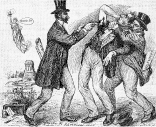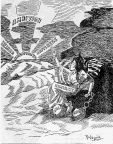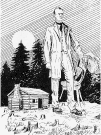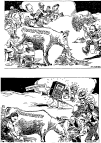Sprinkled throughout the chiropractic literature is a rich tradition of cartooning (Association, 1996) which, like its wider counterparts, tells many fascinating stories. Some of these images are invaluable because of their intended focus, while the value of others lies in what they reveal about the artist, the profession or the times. Chirocartoons mirror and profess the thoughts of chiropractors.
What follows is laid out predominantly by chronological order, and secondarily by subject. Most of the images speak for themselves.

This image of the phrenomagnetic healer was popular in the late 19th century, when D.D. Palmer began his practice.

D.D. Palmer, from the cover of The Chiropractic, January, 1897.

Later sketch of D.D. Palmer used by the National Chiropractic Association (NCA) in the 1930s.

The Statue of Liberty flees her pedastal in this 1904 sketch depicting a medical practitioner injecting a vaccine into an unwilling citizen, who is restrained by a legislator.

The Palmer coat of arms, which appeared in print as early as 1906 (top: from Palmer & Palmer, 1906) featured a mythical creature, the wyvern. The Palmer crest underwent many modifications; in the middle is a version which appeared on the cover of the Palmer School's catalogue, 1908. By the 1980s, the Palmer wyvern had adopted a more relaxed style (bottom).

This cartoon first appeared in The Chiropractor [1910 April:6(4):8,137] and on the inside lids of boxes of "The Chiropractor" cigars. A bare-chested, musclebound B.J. Palmer, reminiscent of the Bernarr Macfadden tradition (Ernst, 1991) stands atop the planet (of which Davenport is the center). On the one hand he fends off death incarnate and with the other reaches out to the sick and ailing. From B.J.'s head, in multiple halo-like waves, emanate the philosophy, science and art of chiropractic.

This 1913 letterhead of the American College of Mechano-Therapy (ACMT) in Chicago depicted an idyllic view of professional education. The school was headed by William C. Schulze,MD (Keating & Rehm, 1995a&b), future president and principal owner of the National College of Chiropractic (1919-1936). The ACMT offered both "correspondence and residence courses."

From B.J. Palmer's Fountain Head News, February, 1915, comes this image, "Ambition," which shows the rays of chiropractic's rising sun inspiring a suffering humanity chained to disease and ignorance.

Palmer graduate James McGinnis advertised with the sketch at top in his practices in Rockwell City and Maquoketa, Iowa (Keating 1998). Dr. Ora L. Brown, a graduate of the Palmer-Gregory College of Chiropractic, defied the medical community in Ohio with this postcard-size advertisement at the bottom.

During the submarine warfare of World War I, with its threat of drafted students and declining student prospects, the Palmer School repeatedly featured this image of a sinking ship in the Fountain Head News in order to encourage enrollment.

B.J. Palmer cartoon, from the Fountain Head News[A.C.23](July 27);7(46):11. These wartime likenesses of B.J. the peacemaker (and entourage) were reprinted from the Utah Labor News, Salt Lake City, July 13, 1998, which ran the cartoon in association with one of Palmer's many speaking tours of the western United States. At upper right, a spine-brandishing B.J. routs the German Kaiser.

This cartoon, entitled "The Mysterious Stranger," first appeard in The Literary Digest October 12, 1918, and was reprinted in the Fountain Head News November 2, 1918, p. 11. The flu epidemic in the years following World War I was devastating, but some believed that perhaps the disease was not so mysterious or foreboding after all. Chirpractors and osteopaths claimed much lower morbidity rates than their allopathic counterparts.

From B.J. Palmer's Fountain Head News, October 4, 1918; by this time, organized medicine was surprised at the rapid growth in numbers and licensing legislation for chiropractors.

This 1919 sketch of the "Constructor of Chiropractic" portrays a Lincoln-like image of Willard Carver,LLB,DC, who was born in a log cabin in Iowa. Carver founded chiropractic schools in Oklahoma City, Washington,D.C., Denver and New York. For much of his career, he stood in political opposition to B.J. Palmer.

This image, combining photographs and cartoons, was used to promote Palmer's early broadcasting effort; from the "Dedication Week" program of Radiophone Station WOC, October 8-14, 1922, p. 5.

The masthead of the cover of B.J. Palmer's Fountain Head News provided a cartoon interpretation of the periodical's title; the metaphor continues in the form of a new magazine from Palmer College, Streams from the Fountainhead.

The seal of the National College of Chiropractic (NCC), featuring an eagle carrying a spine and perched atop the dome of a capitol building, underwent some changes. At top, from the NCC's Sixteenth Annual Catalog (1922); at bottom, from an early issue of the Journal of Manipulative & Physiological Therapeutics, circa 1978. The Latin inscription, "Esse quam videri," translates, "To be, rather than to seem."

This sketch of B.J. Palmer (top) in the "Roycroft" style popularized by the iconoclastic author Elbert Hubbard (bottom) was widely disseminated by the Palmer School in the 1920s and later. It offers a contemplative, Christ-like visage of the "developer" of chiropractic.
U.S. President Woodrow Wilson's campaign for a League of Nations found comic relief in this image, which appeared in the Fountain Head News on May 15, 1920 (p.4)

This image of the Palmer School fronting Brady Street, Davenport and adorned with the antennae of Radiophone Station WOC, appeared on the letterhead of Palmer School stationary in the 1920s.

These cartoons appeared in the Fountain Head News for November 8, 1924. Top: Palmer suggests that he's been working at the feeding end of the cow (Chiropractic), and wonders why he can't have a glass of milk once in a while. Bottom: The neurocalometer forces mixers to give something back to the cow while B.J. draws milk.
Look for part II of "ChiroCartoons & Sketches" in the October 18th, 1999 DC.
Click here for previous articles by Joseph Keating Jr., PhD.












